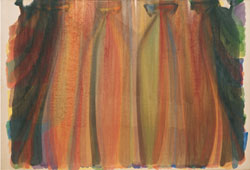1.3
Middle Years Activity
Soak and Stain: A Textural Art Based Project

Morris LOUIS
American 1912–62
Saraband 1959
acrylic resin on canvas
257 x 378.5 cm
Solomon R. Guggenheim Museum, New York
64.1685
For |
Middle Years Students |
Curriculum |
Visual Arts – Creating and Making |
Think About |
The Colour-Field painters, championed by Mark Rothko and Morris Louis, were known for their large planes of colour and deep attraction to myth and spirituality. Characterised by compositions involving broad areas of a single colour, these fields of rich pigment intended to evoke a contemplative state in the viewer. Artists usually apply pigment or paint on the prepared surface of the canvas to create an image. Morris Louis negated this by making the surface and paint collapse into one. He used dyes and thinned acrylic washes to soak and embed pigment within the raw, unprimed fibres of the canvas. |
Aim |
To explore fabric and pigment by soaking and staining techniques inspired by Morris Louis. |
Preparation |
To do this activity you will need to:
|
Individual Task |
Discuss and explain the ways the colours were absorbed by the different fabrics. Describe the ways different overlays of fabrics changed the colour intensities and hues. What mood or visual effects are communicated and how? |
Group Task |
Extend your exploration using different materials:
|
Discussion Questions |
Discuss and share your ideas about colour and texture with others. |